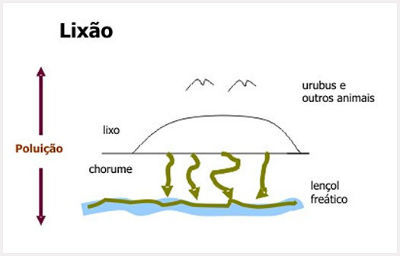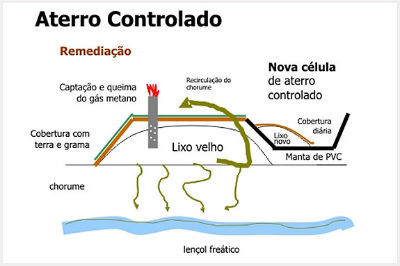Landfill is a place where solid waste discarded by man is dumped. The implementation of this system aims to reduce the impact of garbage in the world, especially the contamination of soil, water and air.
Slurry
The slurry is a dark viscous liquid and smelly releases methane gas (CH 4 ), a major greenhouse, being more damaging to global warming than carbon dioxide (CO 2 ).
The landfill system makes it possible to capture leachate and gases released by garbage, since they are toxic residues that contaminate the soil, air and water courses.
One of the alternatives has been the use of methane for the production of biogas, a biofuel from organic materials. In summary, biogas is an alternative source of clean (renewable) energy produced by organic waste (biomass).
In landfills, there is a mechanism for capturing gases released by fermentation and decomposition of organic matter.
In this way, biogas is produced by combustion that occurs through equipment called “anaerobic biodigester”.
Structure and System of a Sanitary Landfill
The landfill is built on large tracts of land and away from urban centers.
They are usually surrounded by green areas or native vegetation. In São Paulo, to avoid illegal dumping, the landfill must be around 50 meters wide with native vegetation.
First, a large hole is made that must not exceed two meters away from the water table and then, a polyethylene blanket and a layer of small stones are placed, through which the liquids and gases released by the garbage will pass.
In addition, concrete gutters and vertical tubes are installed through which the gases rise, from which some are collected and others released into the atmosphere.
It is important to note that landfills have a specific amount of waste that can be deposited. After that time, the landfill ends its activities there. For this reason, energy sources that use biomass (organic matter) are being increasingly implemented.
How does a landfill work?
After the implementation of the waterproofing, gas capture, leachate and cover system, the landfill works according to the scheme below:

Advantages and disadvantages
Benefits
- Less environmental impact;
- Reduction of the release of methane into the atmosphere;
- Conversion of gases into renewable energy sources;
- Power generation with gas engines.
Disadvantages
- Construction that requires large tracts of land;
- Environmental impacts: pollution of the environment such as leaks of liquids and gases; contamination of groundwater and aquifers; risks to wild animals;
- Limit on the number of layers of garbage;
- Presence of rats, flies and disease transmission;
- High economic cost in implementation and maintenance.
Difference between landfill, landfill and controlled landfill
Dumping ground

The landfill or uncontrolled landfills is an open space for the disposal of waste without a system for the treatment of waste.
The big problem with landfills is the proliferation of insects, such as flies, rats, scorpions and cockroaches that transmit many diseases, in addition to stench, air pollution, soil and groundwater contamination.
The accumulation of residues in landfills is often the cause of flooding. In Brazil, more than 90% of garbage is dumped in landfills.
Landfill

Landfills are spaces for the disposal of garbage that, in turn, undergo treatment and are subsequently covered with layers of sand in order to prevent odors, fires and the proliferation of disease-transmitting animals.
Even with these precautions, the landfill can cause a lot of environmental problems. However, it is a more sustainable alternative than the landfill or controlled landfills.
Controlled Landfill

The controlled landfill is an intermediate location between the landfill and the landfill. It already has a system for capturing leachate and gases, however, not as advanced as the landfill. In summary, the controlled landfill is a cell adjacent to the dump, that is, it represents a quick alternative that minimizes environmental impacts.
Garbage Collection and Treatment
Landfills are systems that, due to their disadvantages, are not entirely appropriate and effective.
In this case, the treatment of waste reduces pollution of the environment in the short term, but it must be accompanied by a selective collection of waste and recycling in order to reduce the proliferation of waste by man.
Nowadays, selective collection, waste separation systems, have several cooperatives of collectors and recyclers. Remember that there are specific landfills for industrial and hospital waste.
In the social sphere, this initiative has shown good results as it generates jobs and enables projects for the environmental awareness of the population.
Recycling and Selective Collection
Both recycling and selective collection has been one of the most important alternatives for the destination of man-made waste.
Thus, selective collection is a system for separating these residues, which is divided by several garbage containers. That is, for each type of material, there is a specific location, which are separated by colors:
- Blue: to papers and cardboard;
- Green: glass;
- Red: for plastics;
- Yellow: for metals;
- Brown: for organic waste;
- Black: for wood;
- Gray: for non-recycled materials;
- White: for hospital waste;
- Orange: for hazardous waste;
- Purple: for radioactive waste.
After separating the waste, many materials can be recycled, that is, reused through the production of new ones.
In summary, selective collection is the separation of materials and recycling is the transformation of raw materials that can be reused. Both processes contribute to the reduction of waste on the planet.
